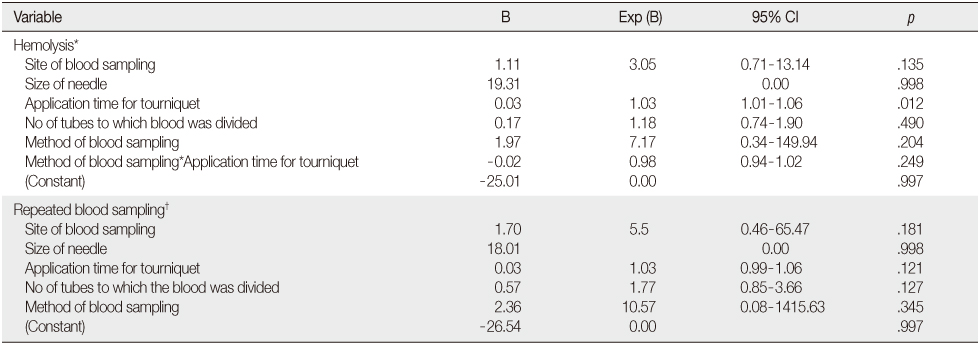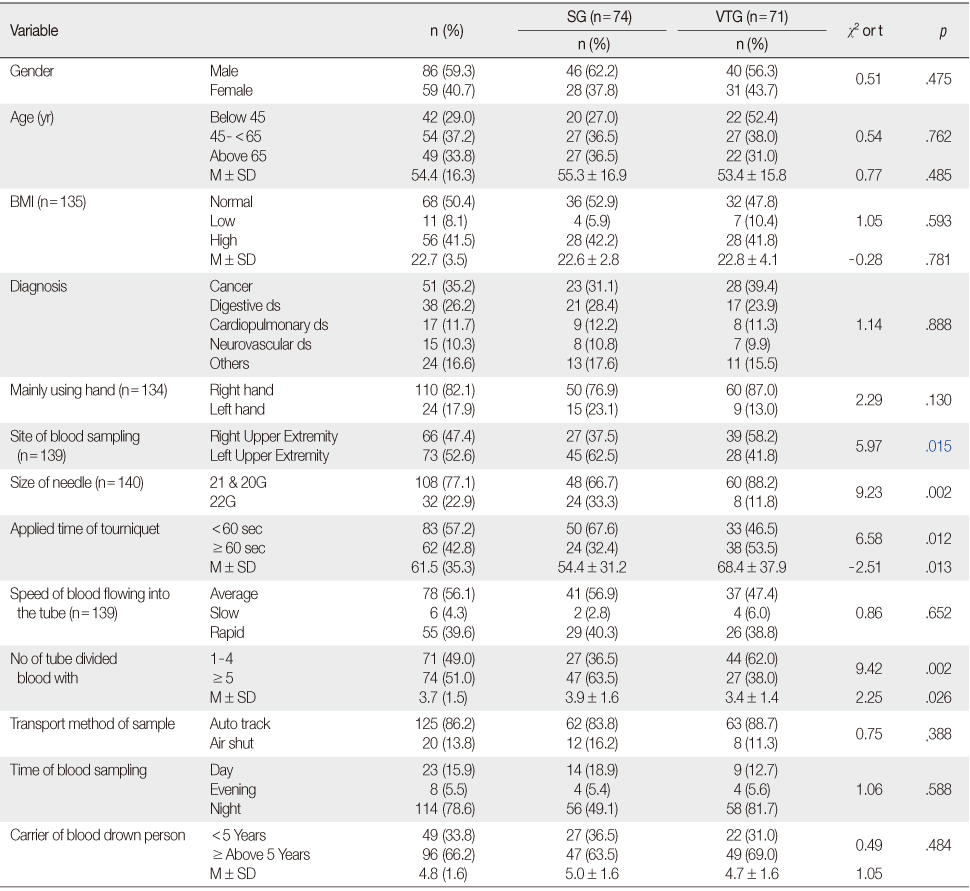Articles
- Page Path
- HOME > J Korean Acad Nurs > Volume 42(3); 2012 > Article
-
Original Article
- A Comparison of the Rates of Hemolysis and Repeated Blood Sampling using Syringe needles versus Vacuum tube needles in the Emergency Department
- Young Hee Sung, Moon Sook Hwang, Jee Hyang Lee, Hyung Doo Park, Kwang Hyun Ryu, Myung Sook Cho, Young Hee Yi, S. Song
-
Journal of Korean Academy of Nursing 2012;42(3):443-451.
DOI: https://doi.org/10.4040/jkan.2012.42.3.443
Published online: June 29, 2012
1Professor, Department of Clinical Nursing Science, Samsung Medical Center, Sungkyunkwan University School of Medicine, Seoul, Korea.
2Assistant Professor, Department of Nursing Science, School of Oriental Medicine in WooSuk University, Jeonbuk, Korea.
3Nursing Manager, Department of Nurisng, Samsung Medical Center, Seoul, Korea.
4Assistant Professor, Department of Laboratory & Genetics, Samsung Medical Center, Sungkyunkwan University School of Medicine, Seoul, Korea.
5General Directror, Department of Laboratory & Genetics, Samsung Medical Center, Seoul, Korea.
6Associate Professor, Department of Clinical Nursing Science, Samsung Medical Center, Sungkyunkwan University School of Medicine, Seoul, Korea.
7Associate Professor, Department of Clinical Nursing Science, Samsung Medical Center, Sungkyunkwan University School of Medicine, Seoul, Korea.
8Adjunct Faculty, School of Nursing, University of Maryland, Baltimore, USA.
- Address reprint requests to: Hwang, Moon Sook. Department of Nursing Science, School of Oriental Medicine in WooSuk University, 443 Samnye-ro, Samnye-eup, Wanju-gun, Jeollabuk-do 565-701, Korea. Tel: +82-63-291-1989, Fax: +82-63-291-1547, msyellow45@hanmail.net
© 2012 Korean Society of Nursing Science
- 762 Views
- 15 Download
- 3 Crossref
Abstract
-
Purpose
- This study was done to compare the rates of hemolysis and repeated sampling in blood samples obtained by a syringe needle versus a vacuum tube needle.
-
Methods
- A randomized, prospective study was used to evaluate the differences between the two blood sampling methods. The study group consisted of patients seen in the emergency department (ED) for blood sampling to determine electrolyte level. ED patients were randomly assigned to either the syringe group or the vacuum tube group. All blood samples were collected by experienced ED nurses and hemolysis was determined by experienced laboratory technologists. Data were analyzed using Fisher's exact test and binary logistic regression.
-
Results
- One hundred forty-five valid samples were collected (74 in the syringe group versus 71 in the vacuum tube group). 5 of 74 (6.8%) blood samples in the syringe group and 8 of 71 (11.3%) in the vacuum tube group hemolyzed. Repeated blood sampling occurred for 2 of 74 (2.7%) and 3 of 71 (4.2%) in each group respectively. There were no significant differences in rates of hemolysis and repeated sampling between two groups (B=1.97, p=.204; B=2.36, p=.345).
-
Conclusion
- Venipuncture with syringe needles can be recommended for ED nurses to obtain blood samples.
This study was financially supported by the research fund of nursing department of Samsung Medical Center in 2010.
- 1. Chi JG. Medical dictionary. 2009;2nd ed. Seoul, Academia.
- 2. Cox SR, Dages JH, Jarjoura D, Hazelett S. Blood samples drawn from IV catheters have less hemolysis when 5-ml(vs 10-ml) collection tubes are used. Journal of Emergency Nursing. 2004;30:529–533. http://dx.doi.org/10.1016/j.jen.2004.10.004.ArticlePubMed
- 3. Derlet RW, Richards JR, Kravitz RL. Frequent overcrowding in U.S. emergency departments. Academic Emergency Medicine. 2001;8:151–155. http://dx.doi.org/10.1111/j.1553-2712.2001.tb01280.x.ArticlePubMed
- 4. Dugan L, Leech L, Speroni KG, Corriher J. Factors affecting hemolysis rates in blood samples drawn from newly placed IV sites in the emergency department. Journal of Emergency Nursing. 2005;31:338–345. http://dx.doi.org/10.1016/j.jen.2005.05.004.ArticlePubMed
- 5. Fang L, Fang SH, Chung YH, Chien ST. Collecting factors related to the haemolysis of blood specimens. Journal of Clinical Nursing. 2008;17:2343–2351. http://dx.doi.org/10.1111/j.1365-2702.2006.02057.x.ArticlePubMed
- 6. Fernandes CM, Walker R, Price A, Marsden J, Haley L. Root cause analysis of laboratory delays to an emergency department. The Journal of Emergency Medicine. 1997;15:735–739. http://dx.doi.org/10.1016/S0736-4679(97)00158-3.ArticlePubMed
- 7. Grant MS. The effect of blood drawing techniques and equipment on the hemolysis of ED laboratory blood samples. Journal of Emergency Nursing. 2003;29:116–121. http://dx.doi.org/10.1067/men.2003.66.ArticlePubMed
- 8. Hong SH, Kim YH. The effect of in vitro hemolysis on various chemistry values. Inje Medical Journal. 1981;2:345–350.
- 9. Kennedy C, Angermuller S, King R, Noviello S, Walker J, Warden J, et al. A comparison of hemolysis rates using intravenous catheters versus venipuncture tubes for obtaining blood samples. Journal of Emergency Nursing. 1996;22:566–569. http://dx.doi.org/10.1016/S0099-1767(96)80213-3.ArticlePubMed
- 10. Kim EJ. Work analysis for the role of the emergency department nurses. Journal of Korean Academy of Nursing. 1998;28:93–103.ArticlePDF
- 11. Kim JH. Comparison of blood glucose concentrations from capillaries and veins in SMBG. Journal of Korean Academy of Nursing. 1998;28:143–147.ArticlePDF
- 12. Kim KJ, Lee HR, Kim K. A study on the job activities of the emergency nurse. The Journal of Nurses Academic Society. 1995;25:709–728.
- 13. Lowe G, Stike R, Pollack M, Bosley J, O'Brien P, Hake A, et al. Nursing blood specimen collection techniques and hemolysis rates in an emergency department: Analysis of venipuncture versus intravenous catheter collection techniques. Journal of Emergency Nursing. 2008;34:26–32. http://dx.doi.org/10.1016/j.jen.2007.02.006.ArticlePubMed
- 14. Ong ME, Chan YH, Lim CS. Observational study to determine factors associated with blood sample haemolysis in the emergency department. Annals of the Academy of Medicine, Singapore. 2008;37:745–748.ArticlePubMed
- 15. Ong ME, Chan YH, Lim CS. Reducing blood sample hemolysis at a tertiary hospital emergency department. The American journal of medicine. 2009;122:1054.e1–1054.e6. http://dx.doi.org/10.1016/j.amjmed.2009.04.024.ArticlePubMed
- 16. Paoloni R, Taghizadeh M, Kouzios D, Janu M. Blood withdrawn through a cannula valve connector does not result in clinically significant haemolysis. Emergency Medicine Australasia. 2010;22:310–315. http://dx.doi.org/10.1111/j.1742-6723.2010.01301.x.ArticlePubMed
- 17. Saleem S, Mani V, Chadwick MA, Creanor S, Ayling RM. A prospective study of causes of haemolysis during venepuncture: Tourniquet time should be kept to a minimum. Annals of Clinical Biochemistry. 2009;46:244–246. http://dx.doi.org/10.1258/acb.2009.008228.ArticlePubMedPDF
- 18. Sharp MK, Mohammad SF. Scaling of hemolysis in needles and catheters. Annals of Biomedical Engineering. 1998;26:788–797. http://dx.doi.org/10.1114/1.65.ArticlePubMed
- 19. Yoon YJ. A study on marketing strategy of medical devise: Focusing on vacuum tube. 2007;Seoul, Hanyang University. Unpublished master's thesis.
REFERENCES

CI=Confidence interval; Site of blood sampling: Left upper extremity(1) vs Right upper extremity(0); Size of needle=22G(1) vs 20 & 21G(0), Method of blood sampling: Vaccutainer(1) vs Syringe(0).
*Hemolysis: -2 log likelihood=64.49, Model χ2 for df 6=20.86 (p=.002); Hosmer-Lemeshow χ2 for df 8=8.63(p=.375), Percentage of correct prediction=90.3%; †Repeated blood sampling: -2 log likelihood=29.70, Model χ2 for df 6=12.99(p=.043), Hosmer-Lemeshow χ2 for df 8=11.52 (p=.174), Percentage of correct prediction=97.0%.
Figure & Data
REFERENCES
Citations

- Investigation of an Acceptable Hemolysis Index Using Re-collected Samples
Hong Bum KIM, Dong Il WON, Kyoung Ae SON, Jin Man KIM, Yu Jin WOO
Korean Journal of Clinical Laboratory Science.2024; 56(1): 32. CrossRef - Harmonization of Hemolysis Index in Clinical Chemistry Laboratory and Its Application as a Result Verification Tool
Sang Shin Pyo, Hyun Su Nam, Young Jong Cha, Seungkwan Lee, Hae Kyung Lee
The Korean Journal of Clinical Laboratory Science.2017; 49(4): 350. CrossRef - Comparison on accuracy of porcelain color reproducibility using two colorimeters
Tai-Il Lee, Jin-Soo Ahn, Young-Soo Kim, Sang-Wan Shin
The Journal of Korean Academy of Prosthodontics.2009; 47(3): 348. CrossRef
Rate of Hemolysis and Repeated Blood Sampling (N=145)
SG=Syringe group; VTG=Vacuum tube group.
*Fisher's exact test.
Characteristics related to Blood Sampling and its Homogeneity by Group (N=145)
SG=Syringe group; VTG=Vacuum tube group
*Fisher's exact test; ds=disease.
Comparison of Hemolysis and Repeated Blood Sample (N=145)
CI=Confidence interval; Site of blood sampling: Left upper extremity(1) vs Right upper extremity(0); Size of needle=22G(1) vs 20 & 21G(0), Method of blood sampling: Vaccutainer(1) vs Syringe(0).
*Hemolysis: -2 log likelihood=64.49, Model χ2 for df 6=20.86 (p=.002); Hosmer-Lemeshow χ2 for df 8=8.63(p=.375), Percentage of correct prediction=90.3%; †Repeated blood sampling: -2 log likelihood=29.70, Model χ2 for df 6=12.99(p=.043), Hosmer-Lemeshow χ2 for df 8=11.52 (p=.174), Percentage of correct prediction=97.0%.
SG=Syringe group; VTG=Vacuum tube group. *Fisher's exact test.
SG=Syringe group; VTG=Vacuum tube group *Fisher's exact test; ds=disease.
CI=Confidence interval; Site of blood sampling: Left upper extremity(1) vs Right upper extremity(0); Size of needle=22G(1) vs 20 & 21G(0), Method of blood sampling: Vaccutainer(1) vs Syringe(0). *Hemolysis: -2 log likelihood=64.49, Model χ2 for df 6=20.86 (
 KSNS
KSNS
 E-SUBMISSION
E-SUBMISSION


 Cite
Cite

